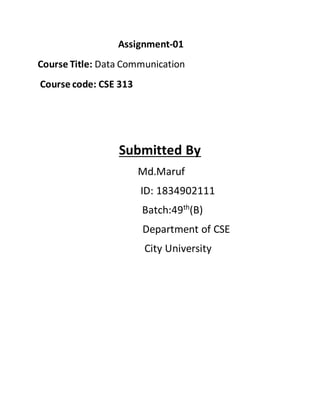
CSE-313 Data Communication Assignment
- 1. Assignment-01 Course Title: Data Communication Course code: CSE 313 Submitted By Md.Maruf ID: 1834902111 Batch:49th (B) Department of CSE City University
- 2. Data communications (DC) is the process of using computing and communication technologies to transfer data from one place to another, or between participating parties. DC enables the movement of electronic or digital data between two or more network nodes, regardless of geographical location, technological medium or data contents. Data Communication System Components: There are mainly five components of a data communication system: 1. Message 2. Sender 3. Receiver 4. Transmission Medium 5. Set of rules (Protocol) Data Flow Communication between two devices can be simplex, half-duplex, or full-duplex as shown in Figure. 1. Simplex Mode – In Simplex mode, the communication is unidirectional, as on a one-way street. Only one of the two devices on a link can transmit, the other can only receive. The simplex mode can use the entire capacity of the channel to send data in one direction. Example: Keyboard and traditional monitors. The keyboard can only introduce input, the monitor can only give the output.
- 3. 2. Half-Duplex Mode – In half-duplex mode, each station can both transmit and receive, but not at the same time. When one device is sending, the other can only receive, and vice versa. The half-duplex mode is used in cases where there is no need for communication in both directions at the same time. The entire capacity of the channel can be utilized for each direction. Example: Walkie-talkie in which message is sent one at a time and messages are sent in both directions. 3. Full-Duplex Mode – In full-duplex mode, both stations can transmit and receive simultaneously. Full-duplex mode is used when communication in both directions is required all the time. The capacity of the channel, however, must be divided between the two directions.
- 4. Example: Telephone Network in which there is communication between two persons by a telephone line, through which both can talk and listen at the same time. Types of Network Topology a) MeshTopology: In a mesh topology, every device is connected to another device via a particular channel. Advantages of this topology: It is robust. The fault is diagnosed easily. Data is reliable becausedata is transferred among the devices through dedicated channels or links. Provides security and privacy. Problems with this topology: Installation and configuration are difficult. The costof cables is high as bulk wiring is required, hence suitable for less number of devices. The costof maintenance is high.
- 5. b) Star Topology: In star topology, all the devices are connected to a single hub through a cable. This hub is the central node and all other nodes are connected to the central node. The hub can be passive in nature i.e., not an intelligent hub such as broadcasting devices, at the same time the hub can be intelligent known as an active hub. Active hubs have repeaters in them. a Advantages of this topology: If N devices are connected to each other in a star topology, then the number of cables required to connectthem is N. So, it is easy to set up. Each device requires only 1 port i.e. to connectto the hub, therefore the total number of ports required is N. Problems with this topology:
- 6. If the concentrator (hub) on which the whole topology relies fails, the whole system will crash down. The cost of installation is high. Performance isbasedonthe single concentratori.e.hub. c) Bus Topology: Bus topology is a network type in which every computer and network device is connected to a single cable. It transmits the data from one end to another in a single direction. No bi-directional feature is in bus topology. It is a multi-point connection and a non-robusttopology becauseif the backbone fails the topology crashes. Advantages of this topology: If N devices are connected to each other in a bus topology, then the number of cables required to connectthem is 1, which is known as backbone cable, and N drop lines are required. The costof the cable is less as compared to other topologies, but it is used to build small networks. Problems with this topology: If the common cable fails, then the whole system will crash down. If the network traffic is heavy, it increases collisions in the network. To avoid this, various protocols are used in the MAC layer known as Pure Aloha, Slotted Aloha, CSMA/CD, etc. Security is very low. d) Ring Topology:
- 7. In this topology, it forms a ring connecting devices with its exactly two neighboring devices. A number of repeaters are used for Ring topology with a large number of nodes, because if someone wants to send some data to the last node in the ring topology with 100 nodes, then the data will have to pass through 99 nodes to reach the 100th node. Hence to prevent data loss repeaters are used in the network. d) Ring Topology: In this topology, it forms a ring connecting devices with its exactly two neighboring devices. A number of repeaters are used for Ring topology with a large number of nodes, because if someone wants to send some data to the last node in the ring topology with 100 nodes, then the data will have to pass through 99 nodes to reach the 100th node. Hence to prevent data loss repeaters are used in the network. e) Tree Topology: This topology is the variation of Star topology. This topology has a hierarchical flow of data.
- 8. Advantages of this topology: It allows more devices to be attached to a single central hub thus it decreases the distance that is traveled by the signal to come to the devices. It allows the network to get isolate and also prioritize from different computers. Problems with this topology: If the central hub gets fails the entire system fails. The costis high because of cabling. Link: https://www.geeksforgeeks.org/types-of-network-topology/